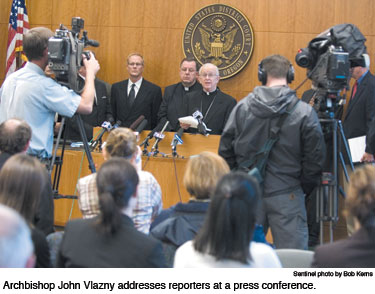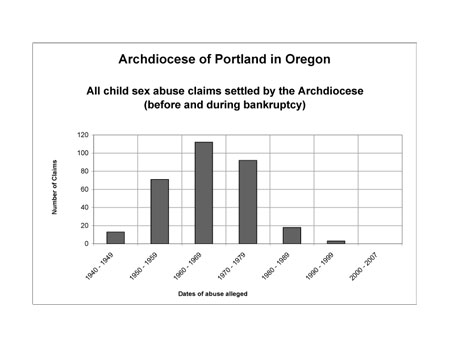By Ed Langlois
Catholic Sentinel [Portland OR]
April 27, 2007
http://www.sentinel.org/articles/2007-17/15338.html
 |
Lawyers defending the Archdiocese of Portland against allegations of child sexual abuse had to get through a thicket created by Oregon law and culture.
Few if any other states have such a combination of statutes and anti-establishment opinion making it so hard for employers with a worker accused of sexual misconduct.
Here are some of the factors:
• Employers can be held liable for acts of abuse by their employees more easily in Oregon than in any other state. A 1999 case in the Oregon Supreme Court, Fearing vs. Bucher, established automatic vicarious liability for Oregon employers. In most states, supervisors are liable only if they received prior notice that the worker had misbehaved in the past. It was no coincidence that sex abuse suits against the archdiocese began coming in shortly after that ruling. Between 2000 and 2004, the archdiocese settled 140 claims.
• Oregon courts can award punitive damages even if the defendant was merely reckless, not intentional, in wrongdoing. That is not the case in Washington state, for example. Before the bankruptcy, two accusers sought a combined $155 million from the archdiocese, mostly in punitive damages, forcing the bankruptcy filing.
• Oregon has a liberal statute of limitations when it comes to taking legal action for sex abuse. It allows accusers to file claims when they become aware of the damage the abuse may have caused.
The state lawmaker who originally pushed through the extended statute in 1991, Kevin Mannix, says employers were not the target of the law. But state courts have interpreted the law to include supervisors. That is why, for example, most of the cases against the archdiocese concern events that happened 30, 40 or even 50 years ago.
"When you are facing a case where the only person who is available to testify is the plaintiff and the person who is accused is dead, the bishops who supervised that person is dead, any fellow priests or parishioners who knew that person are dead and under Oregon law the testimony of one witness is sufficient to prove the case, it makes it difficult," says Tom Dulcich, the archdiocese's legal counsel since 1992.
• Because relatively few Oregonians are involved in local church life, it's more likely a larger section of the public is predisposed to believe allegations of clergy sex abuse. National publicity about scandals across the country could well bias Oregonians, because many do not know a priest.
In court, where lawyers and judges make decisions based on how they think a jury might value a claim, that puts churches at a disadvantage.
Other factors made the 33-month bankruptcy, the nation's first for a Catholic diocese, uncommonly complicated.
In 2004, when the bankruptcy was filed, Dulcich hoped it would be over in two years. It took three, but could have gone much longer, considering the groundbreaking parish property litigation that erupted early on.
From the first moments of the filing, and even before, Archbishop John Vlazny said church law forbad him from seizing parish holdings. Not long after, lawyers for abuse claimants tried to have parish and school property included in the tally of what is available to figure and pay claims against the archdiocese.
After months of legal arguments, U.S. Bankruptcy Judge Elizabeth Perris ruled in test cases involving the real property of nine parishes and a high school, that any interest those parishes and school had in their property would be voided under the Bankruptcy Code. They might still have claims to their properties under the Religious Freedom Restoration Act, a question on which the court did not rule. The archdiocese, the parishes and parishioners committee and the high school defendants all appealed the real property decision. The settlement halted the appeal before a resolution.
In part because of these challenges, Dulcich says filing for bankruptcy was simply an act of wise stewardship. About 160 claimants settled for around $50 million, far less than the amounts sought in pre-bankruptcy suits, which combined amounted to about $500 million.
Had the archdiocese gone to trial in the large 2004 cases and lost, those big awards could have set a precedent that would have proven devastating to archdiocesan resources and mission. Already, no one would lend the archdiocese money and insurers refused to pay more claims.
If the bankruptcy seemed like a distraction, says Dulcich, imagine what scores of trials would be like. Archbishop Vlazny's evangelizing mission of the church would have been seriously impeded.
"It's hard to make disciples when you're spending all day in court," Dulcich says.
Parish property could well have been in greater peril were it not for the bankruptcy. Lawyers in the scores of individual cases could have made claims on the hundreds of millions of dollars of parish and school property.
The average settlement in Portland — about $300,000 — is comparable to claims paid in other dioceses for clergy sexual abuse. It's close to Spokane's average and less than averages in Los Angeles and Orange County.
Some accusers got more than the average, depending on numerous factors. Many got less. Archdiocesan lawyers saw the veracity of many claims as questionable, but settled simply because the cases cost less to pay than to litigate.
In the end, claimants received fair settlements and the archdiocese was able to continue its ministry, which was the hope, says Dulcich, who grew up in Astoria's Catholic community and is now a member of Holy Family Parish in Portland.
During a press conference last week, two lawyers for accusers lauded archdiocesan attorneys Dulcich and Margaret Hoffmann. Kelly Clark noted that they "fought hard but were fair and treated my clients with respect."
Dulcich never felt embarrassed to represent what some onlookers saw as the Goliath of the case.
"It was a privilege to represent the archdiocese, a privilege to represent the archbishop," he says. "I was proud every day."
Dulcich reports that a key to the settlement was the work done by Paulette Furness, Director of Business Affairs for the Archdiocese, and others at the Pastoral Center who worked with lawyers at the Miller Nash law firm to get insurers to come up with more than $50 million to pay claims. It took multiple lawsuits, hours of negotiations and $4 million in legal fees. In the end, 10 insurance companies agreed to buy back their policies, giving money in return for not having to cover the archdiocese any longer.
"The insurance settlement was the financial base on which we were able to exit bankruptcy," Furness says. "You can't settle claims without money."
A gag order, which blocked parties in the bankruptcy from commenting publicly on the deliberations, made some reporters bristle. But insiders say it helped catalyze a resolution because the focus was on the task, not the public cat-and-mouse games.
Tom Stilley, a bankruptcy attorney for the archdiocese, told Judge Elizabeth Perris that the order was "the best thing that ever happened to this case."
A release of archdiocesan personnel documents set for mid-May has been heralded by some claimants' lawyers and by pundits as an act finally getting to the truth. Dulcich notes that many of these documents are already in the public domain. Furness warns that "releasing documents concerning priests and others long dead and events far in the past may show 'transparency'but will not get at the truth of what happened 30, 40 or 50 years ago. Documents alone, out of context and without explanation by those who created them of what actually happened at the time, give only a partial picture -- surely not the full truth -- of what occurred." She and Dulcich caution against judging church leaders of the past who lacked the knowledge and standards of today.
Archbishop Vlazny, who was not around Oregon when the cases of abuse happened, has maintained an open door policy with claimants, meeting with many. But a fair number of lawyers delayed meetings between their clients and the archbishop until settlement numbers were in. That's because once an accuser meets the amiable archbishop, the zeal for recompense tends to fade.
"If they meet him they will have a much harder time wanting to be angry at anonymous bishops because here's a real life bishop who's a wonderful person," says Furness. "It's easy to demonize an amorphous defendant."
 |
Any original material on these pages is copyright © BishopAccountability.org 2004. Reproduce freely with attribution.